Downregulation of microRNA-362-3p and microRNA-329 promotes tumor progression in human breast cancer
- PMID: 26337669
- PMCID: PMC5072442
- DOI: 10.1038/cdd.2015.116
Downregulation of microRNA-362-3p and microRNA-329 promotes tumor progression in human breast cancer
Abstract
p130Cas regulates cancer progression by driving tyrosine receptor kinase signaling. Tight regulation of p130Cas expression is necessary for survival, apoptosis, and maintenance of cell motility in various cell types. Several studies revealed that transcriptional and post-translational control of p130Cas are important for maintenance of its expression and activity. To explore novel regulatory mechanisms of p130Cas expression, we studied the effect of microRNAs (miRs) on p130Cas expression in human breast cancer MCF7 cells. Here, we provide experimental evidence that miR-362-3p and miR-329 perform a tumor-suppressive function and their expression is downregulated in human breast cancer. miR-362-3p and miR-329 inhibited cellular proliferation, migration, and invasion, thereby suppressing tumor growth, by downregulating p130Cas. Ectopic expression of p130Cas attenuated the inhibitory effects of the two miRs on tumor progression. Relative expression levels of miR-362-3p/329 and p130Cas between normal and breast cancer correlated inversely; miR-362-3p/329 expression was decreased, whereas that of p130Cas increased in breast cancers. Furthermore, we showed that downregulation of miR-362-3p and miR-329 was caused by differential DNA methylation of miR genes. Enhanced DNA methylation (according to methylation-specific PCR) was responsible for downregulation of miR-362-3p and miR-329 in breast cancer. Taken together, these findings point to a novel role for miR-362-3p and miR-329 as tumor suppressors; the miR-362-3p/miR-329-p130Cas axis seemingly has a crucial role in breast cancer progression. Thus, modulation of miR-362-3p/miR-329 may be a novel therapeutic strategy against breast cancer.
Figures
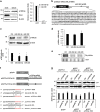

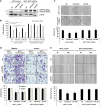
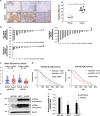
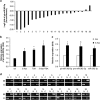
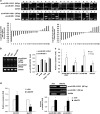
Similar articles
-
miR-181b-3p promotes epithelial-mesenchymal transition in breast cancer cells through Snail stabilization by directly targeting YWHAG.Biochim Biophys Acta. 2016 Jul;1863(7 Pt A):1601-11. doi: 10.1016/j.bbamcr.2016.04.016. Epub 2016 Apr 18. Biochim Biophys Acta. 2016. PMID: 27102539
-
Downregulation of microRNA-27b-3p enhances tamoxifen resistance in breast cancer by increasing NR5A2 and CREB1 expression.Cell Death Dis. 2016 Nov 3;7(11):e2454. doi: 10.1038/cddis.2016.361. Cell Death Dis. 2016. PMID: 27809310 Free PMC article.
-
The miR-24-3p/p130Cas: a novel axis regulating the migration and invasion of cancer cells.Sci Rep. 2017 Mar 24;7:44847. doi: 10.1038/srep44847. Sci Rep. 2017. PMID: 28337997 Free PMC article.
-
Distinct microRNA expression pattern in breast cancer cells following anti-neoplastic treatment: A systematic review and functional analysis of microRNA target genes.Malays J Pathol. 2022 Dec;44(3):367-385. Malays J Pathol. 2022. PMID: 36591707
-
Regulation of microRNA-1 (miR-1) expression in human cancer.Biochim Biophys Acta Gene Regul Mech. 2017 Feb;1860(2):227-232. doi: 10.1016/j.bbagrm.2016.12.004. Epub 2016 Dec 5. Biochim Biophys Acta Gene Regul Mech. 2017. PMID: 27923712 Review.
Cited by
-
Circular RNA hsa_circRNA_002178 silencing retards breast cancer progression via microRNA-328-3p-mediated inhibition of COL1A1.J Cell Mol Med. 2020 Feb;24(3):2189-2201. doi: 10.1111/jcmm.14875. Epub 2020 Jan 19. J Cell Mol Med. 2020. PMID: 31957232 Free PMC article.
-
Predicting miRNA-Disease Associations by Incorporating Projections in Low-Dimensional Space and Local Topological Information.Genes (Basel). 2019 Sep 6;10(9):685. doi: 10.3390/genes10090685. Genes (Basel). 2019. PMID: 31500152 Free PMC article.
-
circNOX4 activates an inflammatory fibroblast niche to promote tumor growth and metastasis in NSCLC via FAP/IL-6 axis.Mol Cancer. 2024 Mar 8;23(1):47. doi: 10.1186/s12943-024-01957-5. Mol Cancer. 2024. PMID: 38459511 Free PMC article.
-
MicroRNA analysis of breast ductal fluid in breast cancer patients.Int J Oncol. 2016 May;48(5):2071-8. doi: 10.3892/ijo.2016.3435. Epub 2016 Mar 10. Int J Oncol. 2016. PMID: 26984519 Free PMC article.
-
MicroRNA-362 negatively and positively regulates SMAD4 expression in TGF-β/SMAD signaling to suppress cell migration and invasion.Int J Med Sci. 2021 Feb 18;18(8):1798-1809. doi: 10.7150/ijms.50871. eCollection 2021. Int J Med Sci. 2021. PMID: 33746597 Free PMC article.
References
-
- Bouton AH, Riggins RB, Bruce-Staskal PJ. Functions of the adapter protein Cas: signal convergence and the determination of cellular responses. Oncogene 2001; 20: 6448–6458. - PubMed
-
- Defilippi P, Di Stefano P, Cabodi S. p130Cas: a versatile scaffold in signaling networks. Trends Cell Biol 2006; 16: 257–263. - PubMed
-
- van der Flier S, van der Kwast TH, Claassen CJ, Timmermans M, Brinkman A, Henzen-Logmans SC et al. Immunohistochemical study of the BCAR1/p130Cas protein in non-malignant and malignant human breast tissue. Int J Biol Markers 2001; 16: 172–178. - PubMed
-
- Barrett A, Pellet-Many C, Zachary IC, Evans IM, Frankel P. p130Cas: a key signalling node in health and disease. Cell Signal 2013; 25: 766–777. - PubMed
Publication types
MeSH terms
Substances
LinkOut - more resources
Full Text Sources
Other Literature Sources
Medical

